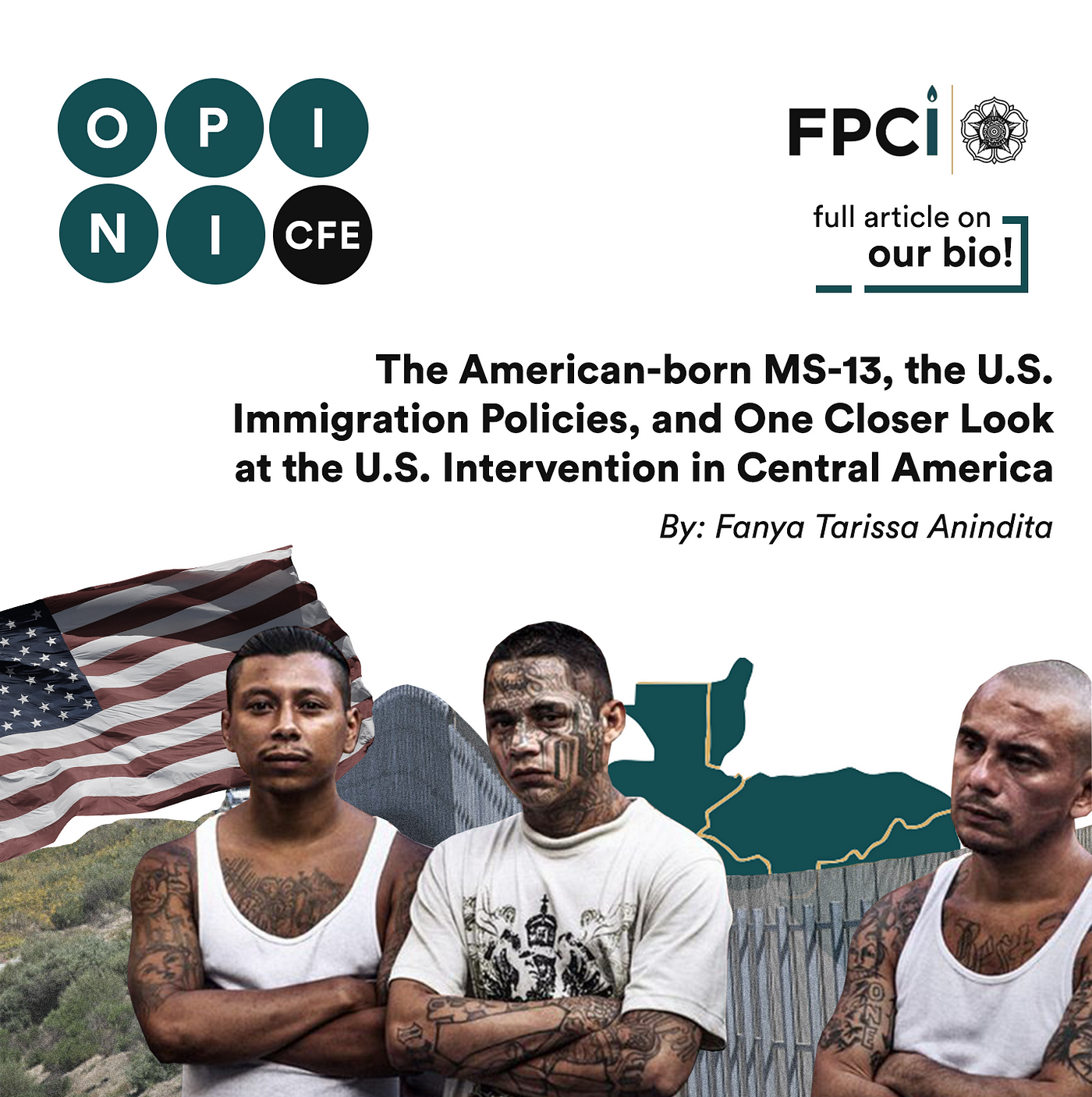What Does the Ms in Ms 13 Stand for
The American-born MS-13, the U.S. Immigration Policies, and One Closer Look at the U.S. Intervention in Central America
Oleh: Fanya Tarissa Anindita
![]()

Two years after President Donald Trump used 'animals' remarks on MS-13 gang members, I'm still intri g ued by the backstory that gave this gang such reputation. It happened in May 2018, at a round-table discussion with California state and local officials. At first, the President explained that he used the language in referring to 'dangerous criminals trying to cross into the U.S. illegally' and later confirmed it to be MS-13 gangs. He finalized it by saying he will always refer to them as 'animals' (Davis and Chokshi, 2018). At certain points, what President Trump and former U.S. Attorney General Jeff Sessions stated regarding the gangs might be agreeable; that they're brutal, violent, and fear-mongering youth (Denvir, 2017). But it's incorrect to call them an imported problem from Central America when it's actually an American-grown mess that has been made worse by massive deportations since the 1990s. And it had a lot to do with El Salvador's Civil War, U.S. foreign policy on Central America, and the immigration policies. So, who is MS-13?
The term MS-13 stands for Mara Salvatrucha-13. It consists of the word 'Mara', a Central American word for 'gang', 'Salva' for El Salvador, 'Trucha', a slang term for 'street smarts', and number 13 for the order of letter M in the alphabet (InSight Crime, 2019). In short, it means 'Salvadoran gang' and it was formed in poor, marginalized Latino neighborhoods of Los Angeles where the far-tougher Mexican gangs also resided — the gang later spread farther to Washington and Northern Virginia — in the 1980s by Salvadoran immigrants who fled their war-ravaged country (InSight Crime, 2019). The gang started from a bunch of teenagers — mostly aged between 16 to 19 — who spent their time listening to heavy metal music, smoking, and drinking before it evolved into picking fights and murdering their rivals, one of them being the 18th St. Gang or Barrio 18, robbery, extortion, racketeering, rape, and kidnapping (Vox, 2018). In their defense, MS-13 was there to protect the young Salvadoran immigrants and refugees who were targeted, threatened, or killed by their rivals or dissenters, such as Mexican gangs (Johnson, 2006). This vicious gang aroused in the face of anti-gang and anti-immigrant efforts launched in the 1990s, mainly as a byproduct of President Bill Clinton's Illegal Immigration Reform and Immigrant Responsibility Act (IIRAIRA) in 1996 which eased the deportation of foreign-born convicted criminals (InSight Crime, 2019; Johnson, 2006).
What happened shortly before the birth of MS-13 was the huge wave of migration from Central America in the 1980s, to put it simply, due to the U.S. interventionist policy towards Central American countries during the Cold War. The U.S. purposefully backed the right-wing government of El Salvador in the civil war against Marxist guerillas organized under Farabundo Martí National Liberation Front (FMNL) that started in 1979 until 1992. In a great deal, the U.S. — under the presidency of Jimmy Carter and Ronald Reagan — contributed to the war through nearly four billion dollars of military aid; supplies of military weaponry and vehicles, provision of elite military advisors, personnel, and units; training of the government's death squads, and other political or military influences necessary to defeat the FMNL by any means, even the most inhumane ones (Encyclopedia Britannica, 2020). The U.S. even helped the Salvadoran government massacred around 1,200 civilians — men, women, and children; be they combatants or not — in 1981 only to later disregard the atrocities they created in the country. This resulted in the pouring of Salvadorans into the U.S. in 1980s through 1990s who fled for their livelihood, proven by the increase of Salvadoran immigrant population in the U.S. from 94,000 to 465,000 people (History, 2018).
In facing this chaotic influx of immigrants, President Clinton signed the IIRAIRA of which provisions largely affected immigrants — legal or illegal — who had been convicted of various crimes, especially gang members, such as MS-13 and Barrio 18. Any non-citizen who committed 'aggravated felony' offenses — which definition and types had been widely expanded to include relatively minor crimes — would immediately be eligible for jail time or deportation (Johnson, 2006). The newly implemented IIRAIRA and hardened counter-gang efforts by the police and government institutions contributed to the spike of deportations in the late 1990s (Johnson, 2006). Subsequently, the U.S. began sending thousands of criminal deportees — homegrown gang members — to El Salvador, Honduras, and Guatemala who were already politically and economically vulnerable and corrupt thanks to decades of Cold-War-induced conflicts with the U.S.
Inadvertently, the U.S. helped the spread of gang's presence to prisons and streets of the receiving countries, worsened their local crime rates, and created new bases for MS-13 members to recruit more youth before clandestinely returning back north via Mexico in a few months (Lopez, Connel, and Kraul, 2005). These deported MS-13 members, who had little to no attachments to their birth countries from migrating to the U.S. at early ages, faced difficulties integrating to the local communities and often resorted to gang life (InSight Crime, 2019). They would quickly be involved in petty to heavy crimes which gradually contributed in making local Salvadoran neighborhoods more dangerous and inhospitable. On the other side, families living in those life-threatening environments are forced to seek better living conditions and economic opportunities by migrating to the U.S. only to be faced with harsh detentions and family separations or accused of being gang members disguised as fake families. Without careful examination, what the U.S. government did was targeting victims of these gang criminals who are legally seeking asylum instead of breaking up the gangs who could illicitly cross the borders at ease (Vox, 2018).
Conclusively, this deportation cycle has been sustaining the perpetual chain of Central American migration into the U.S — a problem that the U.S. has been dealing with for the last three decades while continuously being dragged as a partisan issue. This long-unsolved crisis not only demands resolutions from the seating administration but also demonstrates how certain policies made and executed abroad can significantly affect domestic socio-political stability in the long run.

BIBLIOGRAPHY
Davis, J.H. and Chokshi N. (2018) Trump Defends 'Animals' Remark, Saying It Referred to MS-13 Gang Members [Online]. Available at https://www.nytimes.com/2018/05/17/us/trump-animals-ms-13-gangs.html (Accessed: 9 July 2020).
Denvir, D. (2017) Deporting people made Central America's gangs. More deportation won't help. [Online]. Available at https://www.washingtonpost.com/news/posteverything/wp/2017/07/20/deporting-people-made-central-americas-gangs-more-deportation-wont-help/ (Accessed: 9 July 2020).
Encyclopaedia Britannica. (2020) El Salvador [Online]. Available at https://www.britannica.com/place/El-Salvador/Civil-war (Accessed: 9 July 2020).
InSight Crime. (2019) MS-13 [Online]. Available at https://www.insightcrime.org/el-salvador-organized-crime-news/mara-salvatrucha-ms-13-profile/ (Accessed: 9 July 2020).
History (2018). What's Causing the Central American Migration Crisis? | History [Online]. Available at https://www.youtube.com/watch?v=Ybs3Zn086a0 (Accessed: 7 July 2020).
Johnson, M. H. (2006) National Policies and the Rise of Transnational Gangs [Online]. Available at https://www.migrationpolicy.org/article/national-policies-and-rise-transnational-gangs (Accessed: 9 July 2020).
Lopez, R.J., Connel, R., and Kraul C. (2005) Gang Uses Deportation to Its Advantage to Flourish in U.S. [Online]. Available at https://www.latimes.com/local/la-me-gang30oct30-story.html (Accessed: 9 July 2020).
Vox (2018). Why the street gang MS-13 is an American problem [Online]. Available at https://www.youtube.com/watch?v=CgKpACQyhgk&t=111s (Accessed: 7 July 2020).
What Does the Ms in Ms 13 Stand for
Source: https://fpciugm.medium.com/the-american-born-ms-13-the-u-s-38da5906c5eb